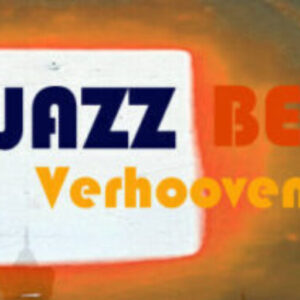Florian Arbenz Conversation 6 und 7
Florian Arbenz Conversation 6 und 7
Conversation #6: Florian Arbenz drums, compositions | Kirk Lightsey (p)
Conversation #7: Florian Arbenz drums, compositions | Kirk Lightsey (p) | Tibor Elekes (b) | Domenic Landolf (sax) – released August 5, 2022
Zwei Langspielplatten, im klassischen Sinn, mit A- und B-Seite jeweils, Platte eins: Duo, Schlagzeug und Piano im Duett, der eine Jahrgang 1937 (Lightsey) , der andere Jahrgang 1975 (Arbenz) – Platte zwei Quartett – ebenso klassisch: Saxophon, Bass, Piano, Schlagzeug – es trifft sich eine geballte Wucht an Musik- und Lebenserfahrung.
Florian Arbenz Conversation 6 und 7 Conversation #6
Ich freue mich sehr, im Rahmen der fortlaufenden Conversation-Reihe ein besonderes Doppelalbum zu präsentieren, und zwar mit keinem Geringeren als der Jazzpiano-Legende Kirk Lightsey
Florian Arbenz über Kirk Lightsey
Kein Geringerer als Kirk Lightsey. Eine Instanz aus der Zeit des Bebop, besser des Neo-Bop unter McCoy Tyner mit Bud Powell-Bewusstsein, Art Tatum Styling in unmittelbarer Nachbarschaft zu Hank Jones und Tommy Flanagan, wie es auf Wikipedia zu Kirk Lightsey heißt. Weitergefragt stößt du auf die englische Wiki mit all seinen Spielpartnern und über 50 Aufnahmen, u.a. mit Chet Baker, Kenny Burrell, Jimmy Raney oder Woody Shaw und Dexter Gordon. Ja kein Geringerer als Kirk Lightsey. Sogar Gregory Porter erscheint auf dem Zettel.
In meiner heimlichen Bibel, die Stolen Moments, gerät selbst der sonst eher zurückhaltende Peter Rüedi 1984 anlässlich des Albums Isotope aus dem Häuschen beim Zuhören von Kirk Lightsey mit Dexter Gordon, eine Sensation in Lugano: diese Sensation spielt manchmal
sparsam wie ein in die Moderne transponierter Count Basie. Auf diesen Teilchenbeschleuniger, auf seine Einsprengsel, seine Vorschläge und seine Hinterhalte ließ sich ein Abend bauen
Peter Rüedi, Stolen Moments 1984 S. 50 über Kirk Lightsey
Auf Porgy und Bess lese ich von Käptn Kirk, ich lese bei Rüedi von einsamer Weltspitze als Sideman. Rüedi weist darauf hin, dass unter der Oberfläche ganz anderer Riffe und Gefährlichkeiten zu überqueren sind, als da wären Randy Weston, Herbie Nichols und schließlich die Tiefseekrake Thelonious Monk. Soweit Peter Rüedi.
Von titanischen Begleitkünsten auf der Aufnahme mit Chet Baker Everything Happens to me und einem Geheimtipp der modern-traditionellen Pianoszene lese ich. Auf S.184 haben wir es mit dem Bud Powell- Nachfolger zu tun, ein Talent von nahezu brutalen Ausmaßen, ein Begleiter von gespenstischer Präsenz und Kraft. Kein geringerer als Kirk Lightsey ist gemeint.
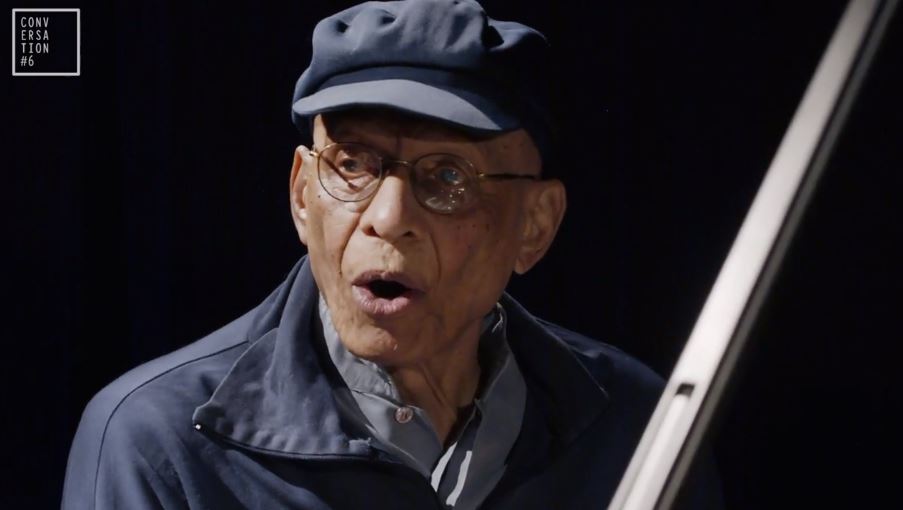
Daher die Freude über die Auflage eines besonderen Doppelalbums, soweit zur Vorrede.
Was wir zu hören bekommen, ist: die Arbeit beginnt von vorn, in hoher Konzentration und akribischer Abstimmung, da kann nicht jeder einfach sein Können rauslassen, er ist gefordert zu fordern zu ordern, zu warten zu bremsen zu führen, loszulassen und nochmal und nochmal zu schauen, zu hören – wo ist der andere. Die Herausforderung steht und ist jeweils in den Gesichtern zu lesen, wer hätte gedacht, dass das noch einmal so intensiv wird.
Mit 14 lernte Florian Arbenz Kirk Lightsey kennen, seit Anfang der Nuller Jahre spielten sie häufiger zusammen: ein Tape aus Ungarn 1999 gibt es auf Youtube – One Finger Snap – Kirk Lightley (p), Florian Arbenz (dr) und Tibor Elekes (b) – ein Tape höchster Fingerfertigkeit und Spielfreude – und einem gerade mal 24 Jahre jungen Florian Arbenz.
Zur Conversation mit Kirk Lightsey im Duo sagt Florian Arbenz:
Als wir die Session in Basel aufnahmen, herrschte tiefstes Corona, alles war zu, wir mussten sogar bei mir im Studio essen und mit der neuen Situation fertigwerden, dazu kommt, dass Lightsey in seiner ganzen langen Karriere zum allerersten Mal im Duo mit Drums gespielt hat, vielleicht oder gerade deswegen empfinde ich die Session als sehr intim und konzentriert.
Florian Arbenz über die Duo-Session mit Kirk Lightsey
Der Opener Sometimes I Feel Like A Motherless Child ist ein Klassiker aus der Zeit der Sklaverei, O my Lord, I gi’ down on my knees and pray … Arbenz und Lightsey entscheiden sich für eine ruhige und vorsichtige Herangehensweise, A long way from home – es scheint, als sei das noch nicht, was sie wollen – der Respekt vor dem Song und seinem historischen Hintergrund ist zum Greifen.
In Ah-Leu-Cha, einem Charlie Parker Stück aus 1948 – das Stück hören wir im Quartett noch einmal – scheint etwas der Zielvorgabe durchzuleuchten: mach du, nein, du, mach du, sie scheinen aufeinander zu warten und wissen, sie müssen Entscheidungen treffen.
Darauf erstmal eine Ruhelage. Lueget von Berg Und Tal – meditativ – dumpfe Schläge aus der Ferne – beruhigendes wie beunruhigendes Grollen, denn es Lueget … das kommt in
Dancing With Kirk schließlich zum Ausbruch, ein freitonaler Tanz, abgerückt von üblichen Konventionen, es steht fast still über drei Akkorden und stampft auf der Stelle, solange, bis es wehtut. Daraus steigert es sich zur Explosionszeichnung, die Explosion aber bleibt aus, wie eine in sich zurückgehaltene Order.
Fee-Fi-Fo-Fum – eine Aufnahme von Wayne Shorter 1966 Speak no Evil – offenbar von Lightsey beigesteuert – ich konnte eine Soloaufnahme von Lightsey auf Youtube erkennen, hier jetzt: es swingt und geht mit einem Blues über die Strecke, aber: es gibt kein Ausruhen oder flüchtiges Durchspielen – noch immer höchste Konzentration, man ahnt, was Peter Rüedi meinte mit bis an die Schmerzgrenze, wenn man sich, Wortwahl Rüedi: mit einem veritablen Monstrum an Swing, Einfühlungsvermögen und orthodoxer Originalität in ein Studio begibt:
Da wird selbst der Freedom Jazz Dance von Eddie Harris zur Herausforderung, offenbar ein Lieblingsstück von Florian Arbenz, es zieht sich wie ein roter Faden durch die Conversations, auf #1, #4 und #5 und #6 war es schon mit dabei – Arbenz darf beginnen. Zwei harte Akkorde von Lightsey – das erschließt sich dir nicht bei einmaligem Hören, schön, dass es dazu das Video gibt, du kannst alles sehen und hören: höchste Bereitschaft, höchster technischer Anspruch und: wer wen mehr fordert: die beiden einander oder sie als Resultat das mithörende Ohr – voller Finessen.
Last but least: der Schlusssatz dieses Duetts geht an Pee Wee als Reminiszenz.
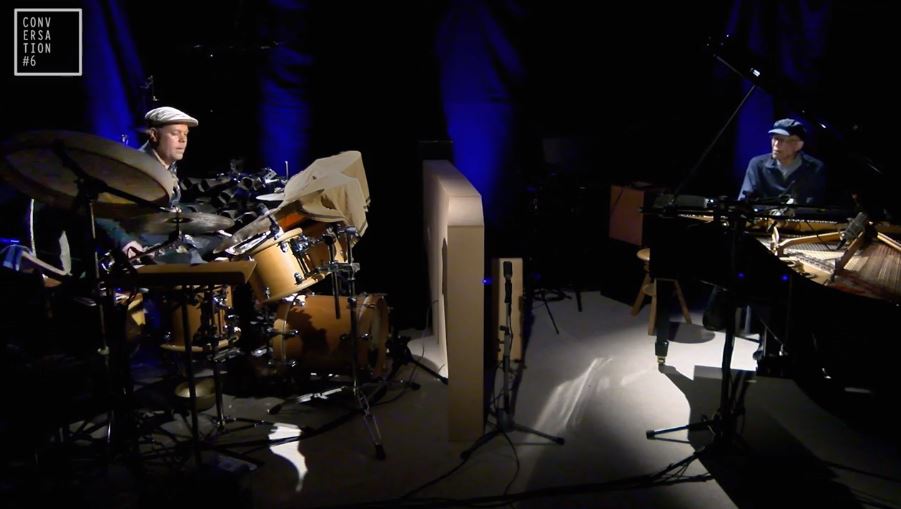
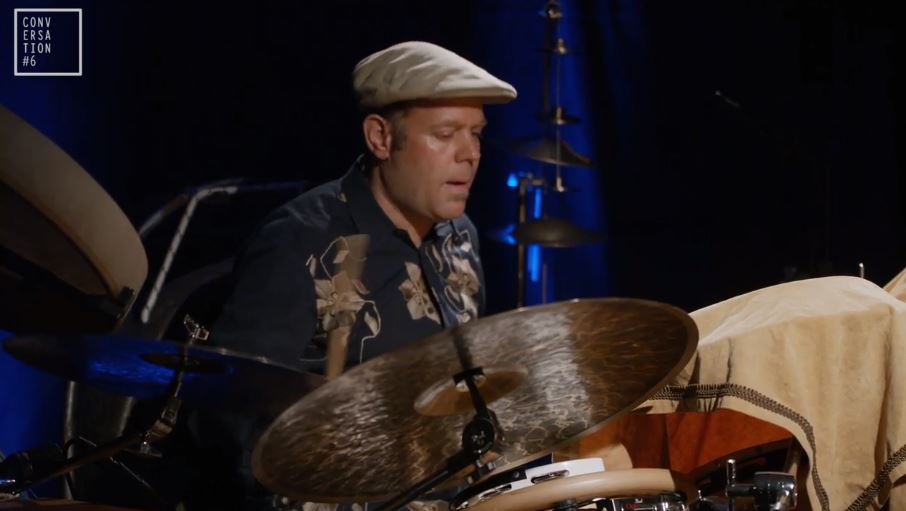
Zu den bislang vorliegenden Conversation #1 #2+3 und #4 gibt es für #1 und #4 jeweils Wikipedia- Einträge: Conversations #1 für Conversation #4 und da Verhoovensjazz längst infiziert ist von diesem Werk mit den so unterschiedlichen Musikern und Musikerinnen (#1 | #2 und #3 | # 4 | #5), lässt es sich kaum objektiv einschätzen oder beurteilen, das scheint auch nicht mehr nötig. Es ist dies ein Opus, das seinesgleichen sucht und von mal zu mal aufregender zu werden scheint. [Sagte ich schon zu Conversation #5 und wiederhole es.]
Florian Arbenz Conversation 6 und 7 Conversation #7
Evolution – der Opener zum Quartett. Eine ganz andere Herangehensweise. Die Fähigkeiten von Arbenz und Lightsey als Sidemen kommen voll zur Geltung, auch schön, wie der Bass von Tibor Elekes auf allen Saiten seines Stegs treibt, bremst, anhält, wieder Fahrt aufnimmt. Wir befinden uns gleich im Fahrwasser moderner Bebop oder Neobop Partituren.
Seeds and Blossom, als Ballade, das Stück, das aus Sicht Lightseys wohl am nächsten dran ist an der Aufnahme mit Chet Baker aus 1984. Arbenz erweist sich als melodischer Drummer mit der hierfür notwendigen Rückhand.
Mit Pinocchio kommt das Erzählerische zurück in den Raum, die ausgedachten Geschichten ziehen mit hohem Tempo davon. Wir hören ein zweites Mal Ah-Leu-Cha – das Charlie Parker Stück – in ähnlicher Absicht, jetzt vier auf vier. Interessant der Umstieg von Dominic Landolf auf die Bassklarinette. Auch interessant:
Kirk Lightsey hält alles bereit, was ein Pianist als Sideman bereithalten soll: nicht nur einen Werkzeugkasten der linken Hand und des Rhythmischen, sondern: das ist deutlich herauszuhören in MasBlue und Habiba – wir wissen längst um das Vermögen und Können des Pianisten, er aber ist für die Räume zuständig, für das Volumen in oder auf dem das Saxophon seine Assoziationen äußert.
Mit Blues On The Corner geht die große Session schließlich zu Ende – wenn Florian Arbenz sich einen persönlichen Wunsch erfüllt hat, und zwar keinen Geringeren als Kirk Lightsey ins Studio zu holen, so dürfen wir als Zuhörer, als Zuhörerinnen feststellen: es ist einmal mehr unglaublich, was in einer so kurzen Zeitspanne wie den letzten zwei Jahren aus einem Studio (der Fabrik) von Florian Arbenz alles zu Tage gefördert wird.
Ich setze meine persönliche Respektnote darunter. Und empfehle auch Conversation #6 und #7

Referenzen Florian Arbenz Conversation 1 bis 6 :
Mark Corroto in Allaboutjazz zu Conversation #4 | The Free Jazz Collective | Jazz in Europe | Jazzfuel | Jazzviews | Downbeat | Jazz-Fun
Florian Arbenz drums, compositions | Kirk Lightsey (p), Tibor Elekes (b), Dominic Landolf (sax)
Siehe auch: Conversation #1 | Conversation #2 und #3 | Conversation # 4 | Conversation #5
English Version Florian Arbenz Conversation 6 und 7
Two long-playing records, in the classical sense, with A- and B-sides respectively, record one: duo, drums and piano in duet, one born in 1937 (Lightsey) , the other born in 1975 (Arbenz) – record two quartet – just as classical: saxophone, bass, piano, drums – a concentrated force of musical and life experience meets.
Florian Arbenz Conversation 6 und 7 Conversation #6
Very excited to present a special double album as part of the ongoing Conversation series, with none other than jazz piano legend Kirk Lightsey!
Florian Arbenz aboutKirk Lightsey
None other than Kirk Lightsey. An authority from the time of bebop, better neo-bop under McCoy Tyner with Bud Powell consciousness, Art Tatum styling in the immediate vicinity of Hank Jones and Tommy Flanagan, as it says on Wikipedia about Kirk Lightsey. Asked further you come across the English Wiki with all his playing partners and over 50 recordings, among others with Chet Baker, Kenny Burrell, Jimmy Raney or Woody Shaw and Dexter Gordon. Yes none other than Kirk Lightsey. Even Gregory Porter appears on the docket.
In my secret bible, the Stolen Moments, even the otherwise rather reserved Peter Rüedi goes out of his mind listening to Kirk Lightsey with Dexter Gordon in 1984 on the occasion of the album Isotope, a sensation in Lugano: this sensation sometimes plays
.
sparingly like a Count Basie transposed into modernity. An evening could be built on this particle accelerator, on its sprinklings, its suggestions and its ambushe
Peter Rüedi, Stolen Moments 1984 S. 50 about Kirk Lightsey
On Porgy and Bess I read about Käptn Kirk, I read on Rüedi about lonely top of the world as a sideman. Rüedi points out that under the surface there are quite different reefs and dangers to cross, as there are Randy Weston, Herbie Nichols and finally the deep sea octopus Thelonious Monk. So much for Peter Rüedi.
I read about titanic accompaniments on the recording with Chet Baker Everything Happens to me and an insider tip of the modern-traditional piano scene. On p.184 we have the Bud Powell successor, a talent of almost brutal proportions, an accompanist of haunting presence and power. No less than Kirk Lightsey is meant.
Hence the joy of the edition of a special double album, so much for the preface.
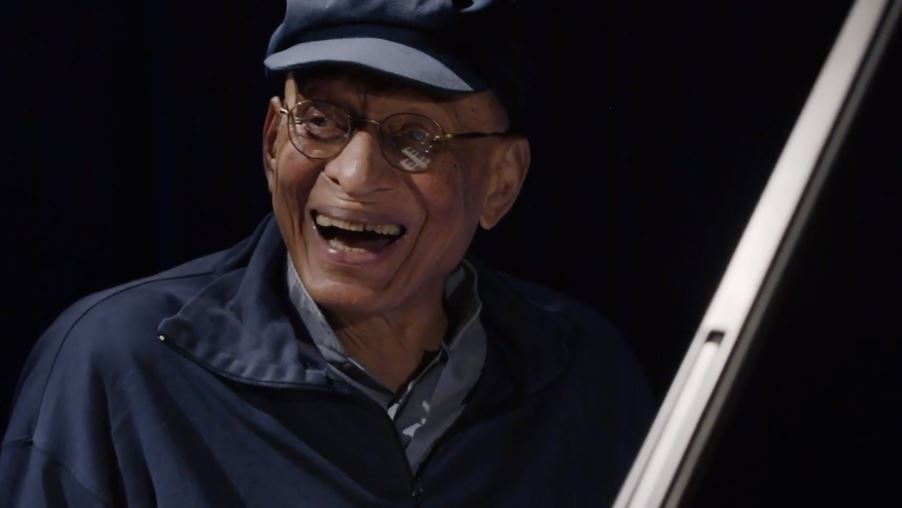
What we get to hear is: the work starts all over again, it becomes a high concentration and very meticulous tuning, there not everyone can just let out his skills, he is challenged to demand, to wait to brake to lead, to let go and again and again to look, to listen – where is the other. The challenge stands and is to be read in each case in the faces, who would have thought that this becomes again so intensive.
At the age of 14 Florian Arbenz met Kirk Lightsey, since the beginning of the noughties they played together more often: a tape from Hungary 1999 is available on Youtube – One Finger Snap – Kirk Lightley (p), Florian Arbenz (dr) and Tibor Elekes (b) – a tape of highest dexterity and joy of playing – and a just 24 years young Florian Arbenz.
On Conversation with Kirk Lightsey as a duo, Florian Arbenz says:
When we recorded the session in Basel, it was deepest Corona, everything was closed, we even had to eat at my studio and cope with the new situation, add to that that Lightsey played in a duo with drums for the very first time in his whole long career, maybe or just because of that I feel the session as very intimate and concentrated.
Florian Arbenz about the duo session with Kirk Lightsey
The opener Sometimes I Feel Like A Motherless Child is a classic from the time of slavery, O my Lord, I gi’ down on my knees and pray … Arbenz and Lightsey opt for a quiet and cautious approach, A long way from home – it seems that is not yet what they want – the respect for the song and its historical background is palpable.
In Ah-Leu-Cha, a Charlie Parker piece from 1948 – we hear the piece again in the quartet – something of the target seems to shine through: do you, no, you, do you, they seem to wait for each other and know they have to make decisions.
On it first of all a resting position. Lueget of Berg Und Tal – meditative – dull beats from the distance – calming as well as disturbing rumbling, because it Lueget … that comes in
Dancing With Kirk finally erupts, a free-tonal dance, departed from usual conventions, it stands almost still over three chords and stomps on the spot, until it hurts. From this it rises to the explosion drawing, the explosion, however, remains out, like an order held back in itself.
Fee-Fi-Fo-Fum – a recording of Wayne Shorter 1966 Speak no Evil – apparently contributed by Lightsey – I could spot a solo recording by Lightsey on Youtube, here now: it swings and goes over the track with a blues, but: there is no resting or fleeting playing through – still highest concentration, one suspects what Peter Rüedi meant with to the pain threshold, if one goes, word choice Rüedi: with a veritable monster of swing, empathy and orthodox originality into a studio:
Even the Freedom Jazz Dance by Eddie Harris becomes a challenge., obviously a favorite piece of Florian Arbenz, it runs like a thread through the Conversations, on #1, #4 and #5 and #6 it was already there – Arbenz may begin. Two hard chords by Lightsey – you won’t understand that after one listen, it’s nice that there is a video, you can see and hear everything: highest readiness, highest technical demand and: who challenges whom more: the two of them each other or them as a result the listening ear – full of finesse.
Last but not least: the final movement of this duet goes to Pee Wee as a reminiscence.
For the so far available Conversation #1 #2+3 and #4 there are Wikipedia entries for #1 and #4 respectively: Conversations #1 for Conversation #4 and since Verhoovensjazz has long been infected by this work with the so different musicians ((#1 | #2 und #3 | # 4 | #5), it can hardly be objectively assessed or judged, that seems no longer necessary. This is an opus that is unparalleled and seems to become more exciting from time to time. [Said I already to Conversation #5 and repeat it].
Florian Arbenz Conversation 6 und 7 Conversation #7
Evolution – the opener to the quartet. A completely different approach. The skills of Arbenz and Lightsey as sidemen are on full display, also nice how the bass of Tibor Elekes drifts on all strings of his bridge, brakes, stops, picks up speed again. We are immediately in the fairway of modern bebop or neobop scores.
Seeds and Blossom, as a ballad, the piece that from Lightsey’s point of view is probably closest to the 1984 recording with Chet Baker. Arbenz proves to be a melodic drummer with the backhand necessary for this.
With Pinocchio, the narrative comes back into the room, the concocted stories pulling away at a high tempo. We hear a second time Ah-Leu-Cha – the Charlie Parker piece – with similar intent, now four on four. Dominic Landolf’s switch to bass clarinet is interesting. Also interesting:
Kirk Lightsey holds everything a pianist should have ready as a sideman: not only a left-hand and rhythmic toolbox, but: this is clearly heard in MasBlue and Habiba – we have long known of the pianist’s ability and skill, but he is responsible for the spaces, for the volume in or on which the saxophone expresses its associations.
With Blues On The Corner the great session finally comes to an end – if Florian Arbenz has fulfilled a personal wish, namely to bring none other than Kirk Lightsey into the studio, we as listeners may note: it is once again unbelievable what can be brought to light in such a short period of time as the last two years from a studio (a head factory) such as Florian Arbenz’s. I put my personal respect mark under this.
I put my personal respect note below. And also recommend Conversation #6 and #7
Florian Arbenz Conversation 6 and 7 Florian Arbenz Conversation 6 and 7 Florian Arbenz Conversation 6 and 7

Florian Arbenz Conversation 6 und 7 Florian Arbenz Conversation 6 und 7 Florian Arbenz Conversation 6 und 7
have a look for:
- Florian Arbenz Conversation 10
- Florian Arbenz Conversation 9 Targeted
- Florian Arbenz Conversation 8 Ablaze
- Florian Arbenz Conversation 6 und 7
- Florian Arbenz Conversation 5
- Florian Arbenz Conversation 4
- Florian Arbenz Conversation #2 und #3
- Florian Arbenz Conversation Condensed #1
- Florian Arbenz Groovy Vibraphon – Convergence
- Florian Arbenz drums

